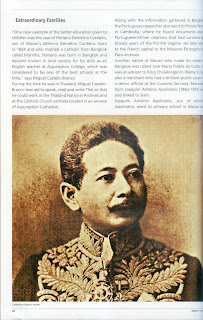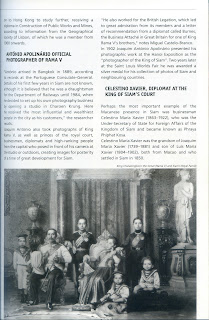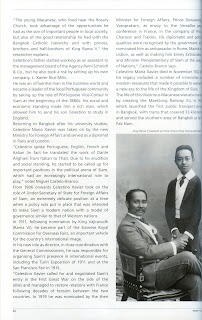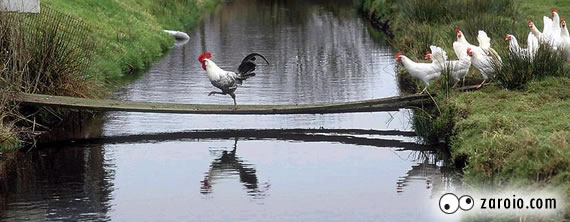Entrevista sobre os Portugueses do Sião
Página 1 de 1
 Entrevista sobre os Portugueses do Sião
Entrevista sobre os Portugueses do Sião
Entrevista sobre os Portugueses do Sião


Aproximando-se a defesa pública da minha tese de doutoramento sobre as relações entre Portugal e o Sião no Período Rattanakosin (1782-1939), concedi há semanas a seguinte entrevista a uma revista de Macau (publicada em língua inglesa) e que transcrevo para quantos se interessam pela matéria portuguesa no Oriente.Prosa ligeira e para divulgação, oferece alguma informação de base que o texto da tese aprofunda teórica e documentalmente.

“One clear example of the better education given to children was the case of Floriano Demétrio Cordeiro, son of Macao’s Zeferino Demétrio Cordeiro, born in 1824 and who married a Catholic from Bangkok called Marinha. Floriano was born in Bangkok and became known in local society for his skills as an English teacher at Assumption College, which was considered to be one of the best schools at the time,” says Miguel Castelo-Branco.

António arrived in Bangkok in 1889, according to records at the Portuguese Consulate-General. Details of his first few years in Siam are not known, although it is believed that he was a draughtsman for the Department of Railways until 1984, when he decided to set up his own photography business by opening a studio in Charoen Krung. Here he received the most influential and wealthiest people in the city as his customers,” the researcher recalls.

Perhaps the most important example of the Macanese presence in Siam was businessman Celestino Maria Xavier (1863–1922), who was the Under-Secretary of State for Foreign Affairs of the Kingdom of Siam and became known as Phraya Phiphat Kosa.

António, ao centro, em retrato colectivo com empresários portugueses de Bangkok

Aproximando-se a defesa pública da minha tese de doutoramento sobre as relações entre Portugal e o Sião no Período Rattanakosin (1782-1939), concedi há semanas a seguinte entrevista a uma revista de Macau (publicada em língua inglesa) e que transcrevo para quantos se interessam pela matéria portuguesa no Oriente.Prosa ligeira e para divulgação, oferece alguma informação de base que o texto da tese aprofunda teórica e documentalmente.
At the end of the 19th and beginning of the 20th century, Macanese families raised the profile of the Portuguese in Siam, who had first made contact with the kingdom three centuries earlier, when navigators and merchants arrived in the region.
Miguel Castelo-Branco spent three years from 2007 in Bangkok studying the relations between Portugal and Siam (now known as Thailand). He says that "from the enormous wealth of documents at Krom Tha (the Port Authority), it is clear that Portuguese investment was focused on buying and selling buildings and opening agricultural companies and alcohol distilleries, which was an extremely lucrative business and made it possible to provide a good education for their children”.
Extraordinary Families

“One clear example of the better education given to children was the case of Floriano Demétrio Cordeiro, son of Macao’s Zeferino Demétrio Cordeiro, born in 1824 and who married a Catholic from Bangkok called Marinha. Floriano was born in Bangkok and became known in local society for his skills as an English teacher at Assumption College, which was considered to be one of the best schools at the time,” says Miguel Castelo-Branco.
During the time he was in Thailand, Miguel Castelo-Branco learned to speak, read and write Thai so that he could work at the Thailand National Archives and at the Catholic Church archives located in an annexe of Assumption Cathedral.
Along with the information gathered in Bangkok, the Portuguese researcher also went to Phnom Penh, in Cambodia, where he found documents about Portuguese-Khmer relations that had survived the bloody years of the Pol Pot regime. He later went to the French capital to the Missions Étrangères de Paris archives.
Another native of Macao who made his career in Bangkok was called José Maria Fidélis da Costa. He was an advisor to King Chulalongkorn (Rama V), but also a merchant who had a brilliant public career as a senior official at the Customs Services. Macanese born Joaquim António Apolinário (1862–1912) was also linked to Siam.
Joaquim António Apolinário, son of António Apolinário, went to primary school in Macao and on to Hong Kong to study further, receiving a diploma in Construction of Public Works and Mines, according to information from the Geographical society of Lisbon, of which he was a member from 1900 onwards.
António, official photographer of Rama V

António arrived in Bangkok in 1889, according to records at the Portuguese Consulate-General. Details of his first few years in Siam are not known, although it is believed that he was a draughtsman for the Department of Railways until 1984, when he decided to set up his own photography business by opening a studio in Charoen Krung. Here he received the most influential and wealthiest people in the city as his customers,” the researcher recalls.
Joaquim António also took photographs of King Rama V, as well as princes of the royal court, businessmen, diplomats and high-ranking people from the capital who posed in front of his camera at the studio or outdoors, creating images for posterity of a time of great development for Siam.
“He also worked for the British Legation, which led to great admiration from its members and a letter of recommendation from a diplomat called Burnes, the Business Attaché in Great Britain for one of King Rama V's brothers," notes Miguel Castelo-Branco.
In 1902 Joaquim António Apolinário presented his photographic work at the Hanoi Exposition as the “photographer of the King of Siam”. Two years later at the Saint Louis Worlds Fair he was awarded a silver medal for his collection of photos of Siam and neighbouring countries.
Celestino Xavier, the diplomat

Perhaps the most important example of the Macanese presence in Siam was businessman Celestino Maria Xavier (1863–1922), who was the Under-Secretary of State for Foreign Affairs of the Kingdom of Siam and became known as Phraya Phiphat Kosa.
Celestino Maria Xavier was the grandson of Joaquim Maria Xavier (1739–1881) and son of Luís Maria Xavier (1804–1902), both from Macao and who settled in Siam in 1850.
“The young Macanese, who lived near the Rosary Church, took advantage of the opportunities he had as the son of important people in local society, but also of the good relationship he had with the Bangkok Catholic hierarchy and with princes, brothers and half-brothers of King Rama V,” the researcher explains.
Celestino’s father started working as an assistant to the management board of the Agency Remi Schmidt & Co., but he also took a risk by setting up his own company, L. Xavier Rice Mills.
He was an influential man in the business world and became a leader of the local Portuguese community by taking up the role of Portuguese Vice-Consul in Siam at the beginning of the 1880s. His social and economic standing made him a rich man, which allowed him to send his son Celestino to study in England.
Returning to Bangkok after his university studies, Celestino Maria Xavier was taken on by the new Ministry for Foreign Affairs and served as a diplomat in Paris and London.
“Celestino spoke Portuguese, English, French and Italian (in fact he translated the work of Dante Alighieri from Italian to Thai). Due to his erudition and social standing, he started to be called up for important positions in the political arena of Siam, which had an increasingly international role to play,” notes Miguel Castelo-Branco.
From 1906 onwards Celestino Xavier took on the role of Under-Secretary of State for Foreign Affairs of Siam, an extremely delicate position at a time when a policy was put in place that was intended to make Siam a modern nation with a model of governance similar to that of Western nations.
In 1911, following nomination by King Vajiravudh (Rama VI), he became part of the Siamese Royal Commission for Overseas Fairs, an important vehicle for the country’s international image.
In his new role as director, in close coordination with the General Commissioners, he was responsible for organising Siam’s presence in international events, including the Turin Exposition of 1911 and at the San Francisco Fair in 1915.
“Celestino Xavier called for and negotiated Siam’s entry in the First Great War on the side of the allies and managed to restore relations with France following decades of tension between the two countries. In 1919 he was nominated by the then Minister for Foreign Affairs, Prince Dewawongse Varoprakarn, as envoy to the Versailles peace conference in France, in the company of Princes Charoon and Traidos. His diplomatic and political qualities were recognised by the government, who nominated him as ambassador in Rome, Madrid and Lisbon, as well as making him Envoy Extraordinary and Minister Plenipotentiary of Siam at the League of Nations,” Castelo-Branco says.
Celestino Maria Xavier died in November 1922 but his legacy included a number of innovative and modern measures that made it possible to welcome a new era to the life of the Kingdom of Siam.
The life of this illustrious Macanese was also marked by creating the Maeklong Railway Co. in 1905, which launched the first public transport service in Bangkok, with trams that covered 33 kilometres and served the southern area of Bangkok as far as Pak Nam.
Publicada por Combustões à(s) 31.7.13 Sem comentários: _________________
Só discuto o que nao sei ...O ke sei ensino ...POIZ


Vitor mango- Pontos : 118178
 Tópicos semelhantes
Tópicos semelhantes» Voltar aos 10.000
» Juristas portugueses no Sião
» Christina Lamb numa interessante entrevista sobre o Afeganistão
» Entrevista a José Miguel Júdice sobre o Caso das Escutas
» SETE MITOS/MENTIRAS SOBRE OS PORTUGUESES
» Juristas portugueses no Sião
» Christina Lamb numa interessante entrevista sobre o Afeganistão
» Entrevista a José Miguel Júdice sobre o Caso das Escutas
» SETE MITOS/MENTIRAS SOBRE OS PORTUGUESES
Página 1 de 1
Permissões neste sub-fórum
Não podes responder a tópicos